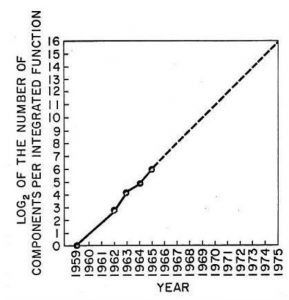History (2015): Moore’s Law Prevails for 50 Years
Projection drove advances in semiconductor and magnetic storage.
This is a Press Release edited by StorageNewsletter.com on May 31, 2018 at 2:29 pmThis article comes from the Computer History Museum.
2015: Moore’s “Law” prevails for 50 years
Projection drove advances in semiconductor and magnetic storage
Original graph from 1965 Electronics magazine article

(McGraw Hill)
In April 1965, Electronics magazine published an article by Gordon E. Moore, director of R&D at Fairchild Semiconductor that estimated the growth in the complexity of integrated circuits over the next ten years. He forecast that “by 1975 economics may dictate squeezing as many as 65,000 components on a single silicon chip.” This required a doubling every 12 months.
In 1975, Moore reported that advances in photolithography, wafer size, process technology, and ‘circuit and device cleverness,’ had allowed his projection to be realized.
On revisiting his projection with new data at that time, Moore modified the future rate of increase in the number of transistors on a chip to “a doubling every two years, rather than every year.” Originally intended to encourage his customers to adopt the most advanced technology in their new computer designs, his prediction emerged as a self-fulfilling prophecy. Dubbed Moore’s Law, semiconductor companies perceived it as a benchmark they must adhere to in order to stay ahead of the competition.
Even as Moore commented in 2003 that “No exponential change continues forever,” his revised prediction has prevailed. From 1971 (Intel 4004, 2,300 transistors) to 2015 (Nvidia Titan, 8,000,000,000), the number of transistors on the largest commercial microprocessor (MPU) devices increased at a CAGR rate of 41%.
I do enjoy nit-picking so here is another one. This statement from the Storage Engine repeated in StorageNewsletter is inaccurate:
“From 2,000 bits/square inch in 1956 (IBM RAMAC) to 1 trillion in 2014 (Seagate), commercial HDD have also increased in areal density at a CAGR of 41%, identical to that of MPUs.”
- Areal Density progress is measured with production units – production RAMAC units began shipping in November 1957 – the units shipped in 1956 were all recalled and mostly destroyed.
- I can find no record of 1 trillion b/in2 by Seagate in 2014 – they did demonstrate such density in 2012, My data shows Seagate Desktop.15 5TB ST5000DM000 (in LaCie) shipping at 826 Mb/in² on or about 2/20/2014 and that the industry did not exceed 1 Tbit/in² until the Toshiba 3TB 2½-inch MQ03ABB300 shipped on or about 5/15/2015 at an estimated 1.1 Mb/in2
From 2,000b/in² in 1957 (IBM 350 disk storage) to 1.1 trillion in 2015 (Toshiba) commercial HDD’s increased areal density at a CAGR of 42%, slightly faster than that of MPUs over a longer period.
Given the continuing slow growth in HDD areal density and absent a breakthrough in technology such as HAMR, it’s likely the HDD areal density CAGR is today slightly below that of MPSs and will continue to slowly fall further behind.
One caveat on the Toshiba data is that the AD is estimated since they do not publish the value. The first published value for AD > 1Tb/in² is Seagate 8TB Enterprise HDDs shipping at 1.334 Tb/in² on or about 9/1/2015. It’s still slightly above MPU CAGR.
For HDDs, where operation depends on mechanical movement of the rotating disk and head track actuator, the improvement in speed performance however has greatly lagged the above CAGR values.
These mechanical limitations have contributed to making SSDs attractive as HDD replacements in high performance applications.
Efforts to produce ever faster and denser SSD solutions includes research into approaches as diverse as Phase Change Memory (PCM), ReRAM/RRAM, and carbon nanotubes.













 Subscribe to our free daily newsletter
Subscribe to our free daily newsletter

